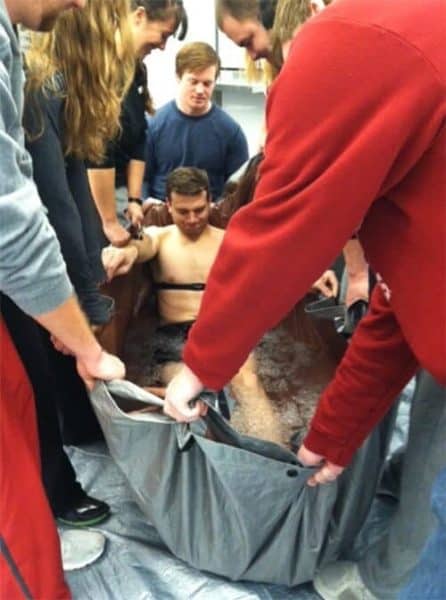A team of University of Arkansas researchers has found that, if a tub of ice water is not available for cooling someone who is suffering from exertional heat stroke, making a “taco” out of a tarp to immerse the person in cold water will also work.
The method – actually called TACO for tarp-assisted cooling with oscillation – requires several people to hold a plastic tarp to serve as a container for cold water while the patient sits or lies in the middle. The people holding the tarp move it by bending their knees to oscillate the water, keeping it moving so the water closest to the patient doesn’t warm and form a barrier to the cold water from doing its work.
Katherine Luhring, a former U of A Master of Athletic Training student who has since graduated, is lead author on the study published in the Journal of Athletic Training. Luhring is now working as an assistant athletic trainer at Florida Atlantic University. She wrote her master’s thesis on the topic.
The article in the November issue is titled “Cooling Effectiveness of a Modified Cold-Water Immersion Method After Exercise-Induced Hyperthermia.”
According to the journal article, the TACO method has been used for several years by the military and at the 2012 Boston Marathon but has never been studied to determine its effectiveness. The U of A study could help reduce sudden death among athletes and military personnel, who may have to play and work in extreme heat conditions, often wearing uniforms and equipment that may hinder the body’s natural cooling mechanisms.
“Many times in the field, we use modalities that may not be evidence-based at first,” said Brendon McDermott, associate professor of kinesiology who directed the study. “But, it’s important to ensure validity in evidence-based clinical practice, which is why we tested the TACO method.”
The National Athletic Trainers’ Association recommends whole-body cold-water immersion as the best method of treating exertional heat stroke by lowering core body temperature quickly. However, the authors point out, other research has shown many athletic trainers don’t implement the method because of a lack of resources, insufficient time to maintain the tub, and difficulty transporting it to venues such as off-road races and military venues.
A tarp is cheaper and doesn’t require advance setup except to have cold water on hand.
The team of researchers – which also included doctoral student Cory Butts; Cody Smith, a master’s degree graduate who is now a doctoral student at North Carolina State University; Jeff Bonacci, clinical assistant professor of kinesiology; Matthew Ganio, associate professor of kinesiology; and Dr. Ramon Ylanan of Advanced Orthopaedic Specialists – used the environmental chamber in the Human Performance Lab on campus to test the method.
They recruited nine men and seven women to exercise in the environmental chamber until their body temperature reached 102 degrees Fahrenheit. The test subjects did this exercise twice at least one week apart. One time, they stopped exercising and simply rested while their body temperature dropped, and the other time they were treated using the taco method. The subjects were monitored the entire time and, for safety reasons, their body temperature was not raised high enough to simulate actual exertional heat stroke.
Results indicated the TACO method provided faster treatment than simply resting to the extent that it is shown to be an effective alternative to traditional cold-water immersion in an emergency situation. The method lowered body temperature by 0.25 degrees plus or minus 0.11 degrees Fahrenheit per minute.
About the Human Performance Lab: he Human Performance Lab is a student-centered facility with a unique dual purpose that includes research and educational components. It serves as a multidisciplinary unit for the initiation and conducting of research focusing upon health, exercise and performance.
About the University of Arkansas: The University of Arkansas provides an internationally competitive education for undergraduate and graduate students in more than 200 academic programs. The university contributes new knowledge, economic development, basic and applied research, and creative activity while also providing service to academic and professional disciplines. The Carnegie Foundation classifies the University of Arkansas among only 2 percent of universities in America that have the highest level of research activity. U.S. News & World Report ranks the University of Arkansas among its top American public research universities. Founded in 1871, the University of Arkansas comprises 10 colleges and schools and maintains a low student-to-faculty ratio that promotes personal attention and close mentoring.


